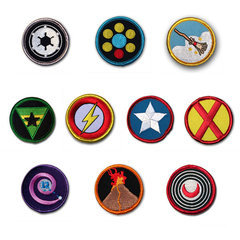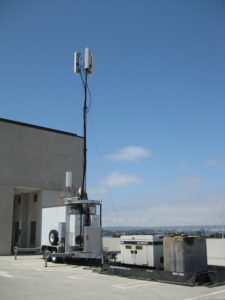- Incredible photo from APOD: Clouds, Birds, Moon, Venus. I’ve finally replaced my Woodbridge Snow photo as my desktop wallpaper at home.
- Microsoft provides an interesting look back at the evolution of the Internet Explorer logo over the past fifteen (yes, fifteen) years.
- 100-year data preservation. A 350-year-old copy of Shakespeare is still readable. But what about that 35-year-old floppy disk?
- Funny: Swedish voters submit SQL injection and JavaScript attacks on hand-written ballot. The article’s title refers back to the XKCD comic about “Bobby Tables.” (via Slashdot)
Category: Computers/Internet
Iconic Imagery
iTunes 10 has shed the CD imagery in its new icon. And yet a floppy disk is still the universal toolbar image for “save.”
Links: Cloud Caps, Kahlua Cupcakes, and the Anti-Vista
 A couple of days ago I clicked on the StumbleUpon toolbar and landed on this incredible photo of lenticular clouds over Mt. Rainer at APOD. It was a bit unnerving, because that picture has been my desktop wallpaper for the past year or so! Good call, though.
A couple of days ago I clicked on the StumbleUpon toolbar and landed on this incredible photo of lenticular clouds over Mt. Rainer at APOD. It was a bit unnerving, because that picture has been my desktop wallpaper for the past year or so! Good call, though.
The Straight Dope experiments with Kahlua cupcakes to determine two questions: How much alcohol is left in each cupcake? (Not much) Can you get drunk? (Not unless you eat so many cupcakes that you’ll be sick anyway.)
Windows 7 is doing what Vista couldn’t: convincing people to replace Windows XP. The best quote in this ZDNet article: “Windows 7 is the Anti-Vista.”
Promoting Old Posts
Weblog Tools Collection recently spotlighted a WordPress plugin to automatically tweet old posts. It seems like a good way to bring attention to a site’s archives, as long as it’s used sparingly. The frequency can be as high as once an hour, which IMO is a good way to lose all your followers, but one post every few days seems like it might be reasonable and even interesting.
I’ve already got a setup in place to show a “flashback” post on the front page, but most of the blog’s traffic seems to come from searches these days. Every once in a while I’ll happen to look at the front myself and say, “Oh, yeah, that was a good one!” and post a link on Twitter or Facebook.
This new plugin posts automatically, and picks an article at random. That’s helpful, because it can find old posts that I’ve forgotten. On the downside, because it’s random, there’s no quality control. It could just as easily pull out something completely inane that was funny for about a week five years ago as it could dredge up a forgotten gem. And there’s always the risk of promoting “Happy New Year!” in August — which is exactly what happened when I tested it on Speed Force.
You can filter out categories, but I think it might be more useful to filter on tags. Sure, it can take a while to go through the archives tagging posts that you feel are worth a second look, but it would certainly improve the signal/noise ratio with this scheme. Even better, there’s a lot more you can do once you’ve tagged your “classics.” Highlight them on archive pages, list some of them in the sidebar, build an index, etc.
Hmm, this might be an interesting project at some point.
Update (August 23): Well, I’ve disabled this for now — on both blogs — because of the lack of control. I’d rather forget to post “Hey, remember this?” than have it clutter up people’s accounts with old linkblogging digests or something similarly pointless. When I have time, I should work on that classics project, both tagging posts and hacking on the plugin.
Links! Alarms, Ghosts of History, Firefly Trek, WW2 Star Wars & More
Serious stuff (news, usability, history, etc.):
- Too many alarms can be as bad as none, if people learn to ignore them. Aesop knew it, but modern society keeps forgetting. (NY Times via NN Group)
- Then and now: Russian photographer Sergey Larenkov blends World War II photos with images of the same locations today. I’m a member of a Flickr group that does this with more general timeframes, Looking Into the Past, though I’ve only contributed one myself. It blends the 1997 and 2007 views of the UCI Student Center.
- The Internet Storm Center offers tips on protecting computers from lightning.
And not so serious:
- Fantastic image: Firefly crew as the Enterprise crew. Classic Star Trek, of course. One thing that really struck me was the reminder that there’s really only one woman among the regular classic Trek cast: Uhura. Nurse Chapel and Yeoman Rand are there, but neither of them would really have had the kind of focus that Kaylee, Zoe, Inara and River have here.
- Incredible custom action figure maker Sillof collaborated with Glorbes on a Star Wars in World War II series.
- The webcomic SMBC presents: The Logogeneplex! I’m pretty sure I’ve read stuff that this was used on. (Warning: archives are NSFW.)
Links: Identity, Kindle, Language, and the Moon
 Fanboy Scouts has launched a series of Merit Badges for Geeks including achievements for Speedster, Mt. Doom, Tie Fighter Pilot, Away Team, and more.
Fanboy Scouts has launched a series of Merit Badges for Geeks including achievements for Speedster, Mt. Doom, Tie Fighter Pilot, Away Team, and more.- Privacy in terms of contextual identity. How you present yourself to your friends is not how you present yourself to your colleagues, and what you’re willing to share in each context is going to be different.
- XKCD is probably right about the future of “old-timey” speech. “Forsooth, do you grok my jive, me hearties?” We have a hard enough time getting the mid-twentieth century right, and that’s with people around who lived it!
- Darryl Cunningham debunks the Moon Hoax in comic-strip form.
- The new Kindle looks nice. They’re starting to get to the price/feature/polish point where I’d be tempted. (Well, except for that pesky DRM…) Also, Amazon launched Kindle for Android recently, but I haven’t tried it out. While it will run on Android 1.6, it’s a bit big for my G1 unless I clear out some other apps.

Internet Access at Comic-Con
 As near as I can tell, there were two main wifi networks at the San Diego convention center this year: “Comic-Con 2010” was open and free…and bogged down. It was enough to post snippets of text one line at a time, but it took forever to start the console for Cover it Live, though, and it wasn’t worth it for uploading photos.
As near as I can tell, there were two main wifi networks at the San Diego convention center this year: “Comic-Con 2010” was open and free…and bogged down. It was enough to post snippets of text one line at a time, but it took forever to start the console for Cover it Live, though, and it wasn’t worth it for uploading photos.
AT&T also had a wireless network, but it required you to either be a customer already or buy access. One of the perks of U-Verse service: free access to AT&T wifi hotspots! Since only paid customers were using it, it was a lot faster. Faster even than our home internet access, in fact.
This was in the lobby, hallways and meeting rooms at the convention center itself. I never really tried to access wifi on the exhibit floor (who has room to sit down, other than people staffing a booth?), and didn’t spend much time on my phone either, except for sending and receiving text messages.
Over at the Hilton, however, access was virtually nonexistent: No wifi as near as I could tell, and even phone access was spotty. I saw people texting in the Indigo Ballroom, but the ones nearby were all on iPhones (AT&T) or Verizon. I had absolutely no T-Mobile signal in that hotel, even though it was perfectly fine everywhere else. Katie had the same problem at Indigo last year, and we were hoping it might have improved. No dice.**
One reason I didn’t worry too much about having constant net access: I spent way too much time last year online. Liveblogging aside, this year I wanted to focus more on actually being there. Last year I posted about 30 messages a day to Twitter. This year it was closer to 10 posts total.
So of course, now I’m spending lots of time after we get back writing things up…online.
*Yes, I know the photo is of a cell phone tower, not a wifi hotspot, but I didn’t take any pictures of wifi routers and this is the next best thing.
**Actually, there was a whole booth full of dice, but it was over on the main floor.
»Full index of Comic-Con posts and photos.
